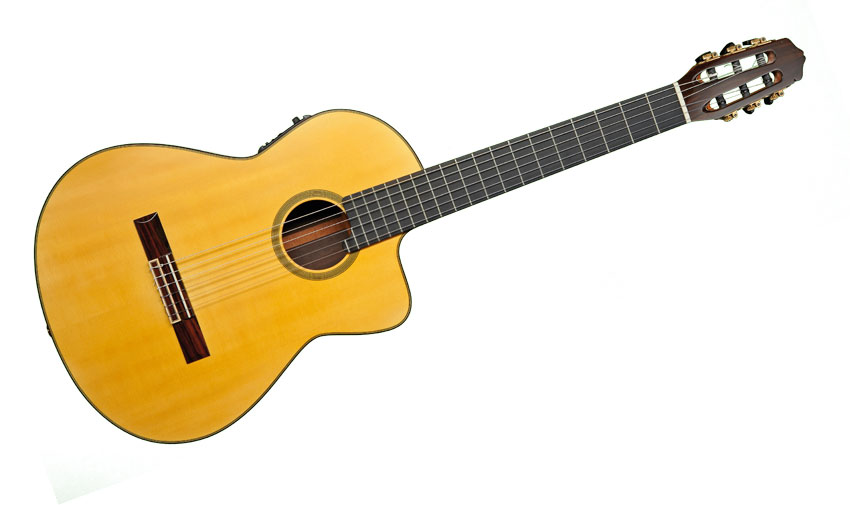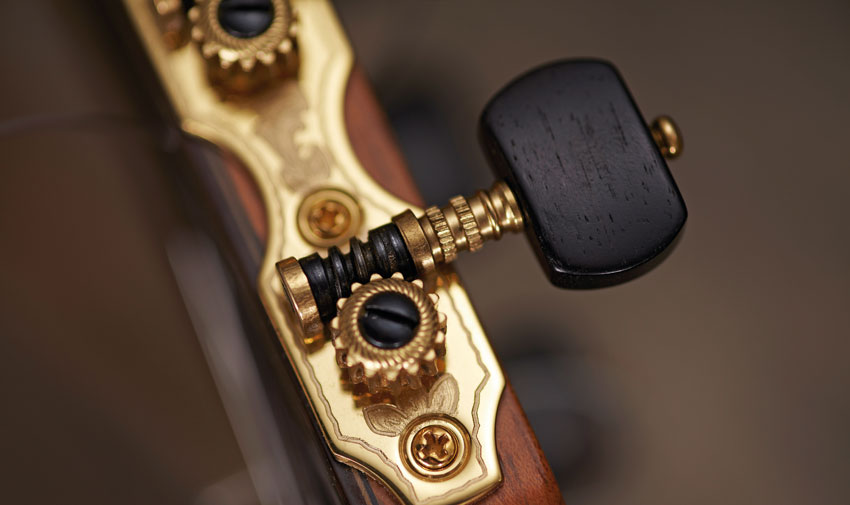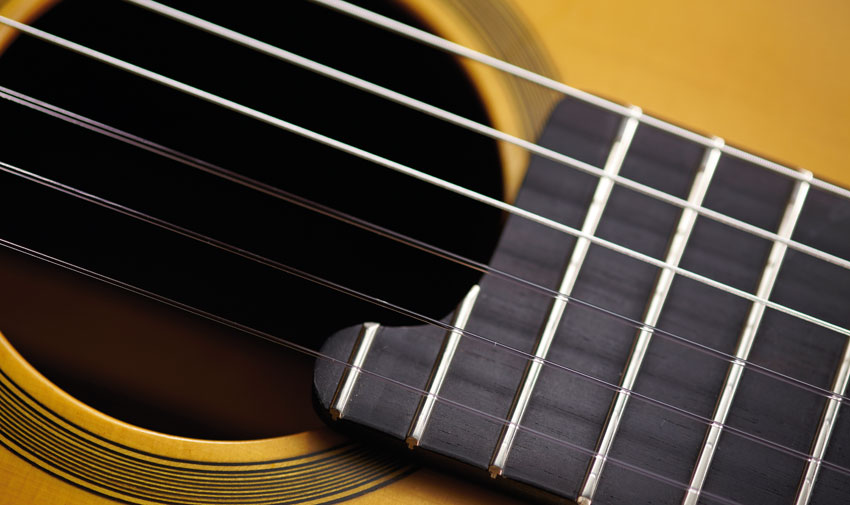MusicRadar Verdict
Here's a guitar that proves that not all innovation comes from the major brands. A beautiful instrument.
Pros
- +
Detailed build. Blend of construction styles. Acoustic and Aura sounds. Tonal flexibility.
Cons
- -
Hard-to-see preamp control legends.
MusicRadar's got your back

Chris George Custom CE-N

Tuners

Soundhole
If you can't find the perfect guitar, why not have one made by a reputable custom builder? The Chris George Custom CE-N is our (successful) attempt to do just that.
Back in 2012, this writer concluded a Longterm Test on Godin's Multiac Encore Nylon and Multiac Grand Concert SA with this sentence: "My search for the ideal thinline stage electro continues, and I'm beginning to think that this instrument might well come from a custom maker, not off the peg."
No sooner had the review hit the streets, than Lincoln-based custom guitar maker Chris George was on the phone. "Can I help?"
"Our design brief was not to produce a classical guitar; rather a nylon-string electro that would work on stage under often adverse conditions"
Chris has been featured here numerous times, initially for making superb electrics incorporating the guts of Line 6's Variax. And while he might be better known for his electrics, Chris has always built acoustics too (primarily of the steel-strung variety), while a rather fine baritone is among his most recent flattops. But a nylon- string? Yes, he's made those, too, but he fancied honing his art in that area. So, what better guinea pigs than us?
Our design brief was not to produce a classical guitar; rather a nylon-string electro that would work on stage under often adverse conditions. Just plonking a pickup in a classical guitar wasn't the way forward - we'd need onboard control: tuner, feedback-rejection and an overall slightly heavier build. Plus, by reducing the body depth by 25 per cent, Chris hoped a primary cause of feedback would be reduced without compromising the acoustic sound.
But it wasn't just feedback- rejection that was at stake: we really wanted to see if we could get a more accurate 'mic'd' sound on stage without, of course, using a microphone.
We contacted Fishman for advice on the subject, and the company concluded the best option was to install its new Aura Pro preamp. It allows you to upload four Aura images into the preamp, then mix those with the undersaddle Matrix - the type of pickup most untroubled by feedback.
We don't have space to describe the whole design and making process but, in brief, we started the project by spending a day spec'ing our go-to guitars, including a well-gigged and recorded Yamaha NCX2000. Armed with dimensions, body outlines and, for style, a mutual love of the Selmer-Maccaferri guitars, Chris headed back to his Lincoln-based workshop to start the design.
The Result
In many ways, Chris's eventual design is very traditional. The basic outline, neck shape and width came from a 1968 concert classical (built in Madrid by Juan Alvarez), which also informed the wood choice: European spruce top, Indian rosewood back and sides, a cedar neck, ebony 'board, rosewood head-facing and bridge. But the cutaway and headstock, not to mention soundhole rings and the slight fretboard overhang, are all inspired by those classic Selmer-Maccaferris.
Along with the Fishman Aura preamp, other modern touches include two graphite reinforcing bars buried in the neck instead of a modern truss rod (a very un-classical guitar feature).
"It's a belt-and-braces feature," says Chris, and goes on to explain the rationale. "Numerous classical guitars use an ebony [reinforcing] strip; some makers use carbon-fibre rods - I've used them on mahogany-necked steel-strings - so I thought, why not? They add a great deal of stiffness."
"Nylon-string necks are much wider than steel-strings, yet here the shaping - a big D - feels excellent"
The top's thickness and the bracing pattern are crucial to any acoustic, steel- or nylon-string, but the latter's lower-tension strings require a thinner top and lighter bracing. Chris looked to one of the classical-building greats, Ignacio Fleta, and sought the counsel of Boston-based classical maker, and good friend, Earl Marsh.
"The Fleta strutting was modified, and the typical Fleta diagonal transverse harmonic bar dispensed with," Chris explains. "Here, I took advice from Earl Marsh, and included his secret reverse-engineering idea of modifying the shaping of the nine fan struts - I can't say more, or I'm dead!"
Many classical makers (though not all) build in a 'freer' manner than the majority of steel-string makers, often without an outside mould; initially, the top is constructed face down on a 'solera' - a scooped workboard.
"Mine was a much simplified form," Chris says, "with a shallow[2mm] 'scoop' below the soundhole to give the front its 'dome' - this is much less than on my steel- string acoustics. I found using the solera a really pleasing way to work."
He also chose a dovetail neck-to-body join over the more classical-style 'slipper' heel. "It was partly because that's what Fleta did, but also it gave me more freedom later on to select what action I needed to give the guitar. On a 'real' solera build, the neck angle is pretty much fixed unless you taper the fingerboard."
Regardless of how he got there, the craft is superb. Nylon-string necks are much wider than steel-strings, yet here the shaping - a big D - feels excellent. The thinline body is beautifully joined, the rosewood binding very classical and simple. Little flourishes, such as the centre-joined bookmatched rosewood headstock facing, illustrate this is no hurriedly built factory guitar, while the German-made Rubner tuners exude quality in both appearance and function.
The closely grained spruce top has a vintage-y yellow tint with an off-the-gun satin nitrocellulose finish. The back, sides and neck are again nitrocellulose, but cut back and buffed by hand to a subtle sheen, very similar to Lowden's superb finish.
Sounds
Taking effect on the sound, and indeed feedback reduction, out of the equation momentarily, the thinline body depth creates a very comfortable, intimate instrument, especially played seated on your right leg (not classical style).
"There's a beautiful balance and evenness to the response"
Sound-wise, we are surprised by the volume; it's almost as big as our full-depth Yamaha NCX, with a trimmer, but not deficient, low-end. There also seems to be a little extra string tension, a little more fight, which for stage use can be important - especially if you're crossing over from steel- strings. There's a breathy presence to the tone, too, which really suits more Latin-y styles, but dig in a little and a more percussive Spanish sound emerges. Above all, there's a beautiful balance and evenness to the response.
Amplified, of course, the emergent sound depends on which Aura images you load into the preamp and how you mix them, or not, with the undersaddle pickup. It's a simple process: using the supplied USB lead, you drag and drop from Fishman's image library. Our first selections all sounded good, but one really suited the guitar: 'Fishman Nylon #05', recorded with a DPA 4011 mic.
The crucial thing about this preamp is that you can EQ the images (and save the settings for each of the four slots) separate from the undersaddle. Our first direct-in recording tests produced excellent results with the blend turned to full Aura - there's a realism that this writer hasn't heard from any other system.
Live, however, it's less straightforward. The full Aura tone is certainly a bit lively in terms of feedback potential, and although the anti-feedback filter works exceptionally well, we found we were mixing in around 40 to 50 per cent undersaddle.
This ability to blend on the fly is extremely useful, depending on the style you're playing. But the system does have its disadvantages: the lettering is ultra-small, and for those of us of a certain age, especially in dim onstage conditions, we'd need a torch and some reading glasses!
Take care with that phase switch, too - it has a substantial effect on the low-end. The anti-feedback filter is very good, and the tuner extremely accurate and untroubled by ambient noise - as we found while tuning up next to a 40-piece orchestra in full swing. But that's another story...
"Yes, £2,000 is a lot of money, but for a handmade instrument employing state of the art electronics - it's actually cheap."
True custom guitar makers may seem a dying breed, especially as virtually every guitar, amplifier and effects pedal imaginable seems available from familiar production brands. So, why would anyone consider an instrument like this?
We found ourselves somewhat dissatisfied with the available options, irrelevant of price. Why should we put up with things that are nearly right when, in this instance at least, we can create something that's quite unique and bespoke, for not a lot more money?
Of course, we don't all have the cash to indulge our fantasies, but when you think most serious classical makers will charge at least twice as much for an acoustic instrument, we can only conclude that, yes, £2,000 is a lot of money, but for a real handmade instrument employing state of the art electronics - a true one-off - it's actually cheap.
Chris George is a great custom maker imbued with the traditions that go back many decades, but he's not afraid of new technologies, materials and styles. Above all, as this instrument proves, he listens to what you, the player, wants. So, when you consider your ultimate guitar, consider makers such as Chris. That is, of course, if you dare to be different.
Dave Burrluck is one of the world’s most experienced guitar journalists, who started writing back in the '80s for International Musician and Recording World, co-founded The Guitar Magazine and has been the Gear Reviews Editor of Guitarist magazine for the past two decades. Along the way, Dave has been the sole author of The PRS Guitar Book and The Player's Guide to Guitar Maintenance as well as contributing to numerous other books on the electric guitar. Dave is an active gigging and recording musician and still finds time to make, repair and mod guitars, not least for Guitarist’s The Mod Squad.
"I’ll let y’all know how rehab is. I hear it’s super fun": Drunk on stage - our pick of music’s most legendary under-the-influence performances
“So I’m standing in the vocal booth one night and I felt Johnny’s presence. I am not a woo-woo, but I felt his presence pushing me": Sheryl Crow says it felt like Johnny Cash was with her when she recorded her vocals for their posthumous duet
“Chris, that’s not how it goes”: Chris Martin does his best Bruno Mars impression as Rosé joins Coldplay on stage to perform APT in South Korea










